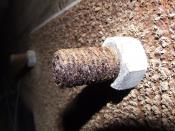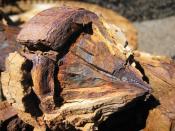Marine Corrosion
In March 2009, 620 tonnes of ammonia nitrate in shipping containers fell off the Pacific Adventurer. A surveillance ship located 5 containers at a depth of 150m and 10 containers at a depth of 2000m. In the marine environment, these shipping containers will almost certainly corrode, at both 150m depth and 2000m depth. If these shipping containers were to corrode, the ammonia nitrate would then leak out causing various environmental problems. While corrosion will defiantly happen if the containers are unattended to, it is possible to prevent the corrosion through the use of various methods.
In the marine environment, galvanic corrosion occurs on the shipping containers, as the environment has the attributes of a galvanic cell. The anodic parts of the container are where the oxidation occurs, causing the Fe to lose electrons. At the cathodic sites, however, the water gains electrons and reduces the water that is in contact with the iron.
The corrosion that occurs on these shipping containers will generally be uniform or evenly-distributed corrosion. Since there are no preferred cathode and anode sites on the iron, these locations will constantly shift due to polarization effects, or the change in the electrochemical potential in areas of the containers caused by the exchange of electrons.
Above are the two half equations for the oxidation and reduction reactions of corrosion. For this cell, the total electrode potential can be found by subtracting the electrode potential of the oxidation reaction from the reduction reaction.
From this we can conclude that corrosion is spontaneous as the E-cell is over 0. This proves that rusting is purely a chemical process that can occur on its own, without any external energy input.
Combining the two half equations, we can see the net equation of corrosion
The aqueous iron ions and hydroxide...


